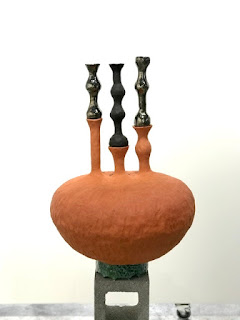Held
Daine Singer, rear 90 Moor Street, Fitzroy 3065
26 February 2020
Interesting combination of materials acrylic, acrylic medium on canvas, calico, cardboard, glazed earthenware base.
 |
| Peaks |
 |
| Fuse |
 |
| Do It Yourself |
 |
Patch work
|
Kate Tucker: Held, catalogue essay by Amelia Wallin
“The history of framing,” writes artist Celine Conderili, “is impossible to find” (Support Structures 2009: 9). That which holds, supports, underwrites, and sustains is often overlooked, it is so entangled within the minutia of everyday life that it cannot be subtracted from it. From the scaffolding that upholds buildings to the reproductive labour that sustains us, the familiarity and ordinariness of support is responsible for its omission. In Held, Kate Tucker’s current exhibition at Daine Singer in Melbourne, the act of upholding is equal to that which is held and the apparatus of support is celebrated.
Materially ambiguous, and often small in scale, what Tucker terms her “slab paintings” and their ceramic counterparts are none the less monumental. In 2015 Tucker first exhibited a series of paintings with ceramic supports designed to delicately uphold her small canvases. Over a five year process, the ceramic structures have expanded to surpass their function as supportive apparatus. In Tucker’s most recent series, colours and patterns are extended from the plane of the canvas onto the ceramics, creating the effect of a symbiotic unit where neither element is more dominant despite their material and functional discrepancies. Material polarities extend throughout the exhibition, as the artist experiments with absorption and repulsion in the form of slick glazed ceramics, porous earthenware, and acrylic paint across multiple surfaces.
Drawing from a proficiency with Photoshop and a past life as a textile and digital designer, Tucker’s paintings are materially dense. Not content with the constraints of the canvas, Tucker devised her layering technique to mimic the openness of digital operations such as Photoshop, specifically the ability to go back and rework imagery across various layers. Through her processes of layering paint, glue and fabric, the artist’s materials — canvas, linen, cotton, digitally printed cotton, cardboard, acrylic — are indivisible from each other. The absorption, expansion and hardening of each layer give form to the duration of their making. The result is a weighty object, situated between painting and sculpture.
For many artists, time in the studio comes always at the expense of something else. Tucker’s works evoke the discipline and endurance of a studio practice and the unspoken sacrifices that this entails. The three earthenware sculptures of grasping hands, “Attend”, “Assurance”, and “Entangled” (all 2019) evoke this sense of struggle. For these works, Tucker drew inspiration from vintage DIY instructional manuals, illustrated with black and white photographs of disembodied gesturing hands, engaged in various tasks of fixing, building, making. In their sculptural form, the hands are at once supportive and restrictive, nurturing and containing.
To be held is to be nurtured, supported, cared for, but one can also be held back. Countless women have written about the challenges of motherhood in the context of the arts in particular. The isolating experiences of motherhood led artist Moyra Davey to compile and edit The Mother Reader, a collection of texts on the ambivalence of motherhood, writing, art and shame. In her introduction to the volume, Davey speaks of the treasure hunt like the experience of discovering sources in the footnotes, citations, and introductions of texts, through which she unearthed a community of writers struggling with the expectations and conditions of motherhood in a Western context. Tucker too, speaks of the challenges of being an artist parent; the limits of time, the enduring demands of care. Like the frame beyond the picture, motherhood is commonly thought of as supportive or supplementary, and as with all support systems, its everywhere-ness makes it an elusive concept to grapple with. Yet through its attention to that which upholds, Tucker’s exhibition realigns the supportive with the supported. Held reminds us of the structures, systems, and applications of support that may go unnoticed.
- Amelia Wallin, 2020

























